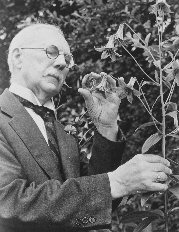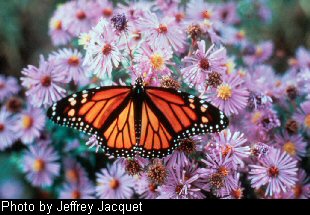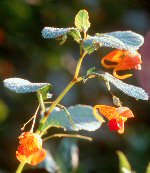Nature's Last Hurrah
By Nanci Bross-Fregonara
 The golden days of October in the Mountain State are truly inspiring. When the sun shines, the sky is a clear azure. At dusk, the evening light casts a golden glow on the hillsides already ablaze with the autumnal palette of yellow, orange and red. And while the beautiful flowers of summer—the bellflowers, coneflowers and hollyhocks — have gone to seed, some of nature's loveliest perennials are in their prime. The golden days of October in the Mountain State are truly inspiring. When the sun shines, the sky is a clear azure. At dusk, the evening light casts a golden glow on the hillsides already ablaze with the autumnal palette of yellow, orange and red. And while the beautiful flowers of summer—the bellflowers, coneflowers and hollyhocks — have gone to seed, some of nature's loveliest perennials are in their prime.
Joseph E. Harned, one of the region's foremost turn-of-the-century botanists and author of Wild Flowers of the Alleghenies once wrote: “As the heavens burst into their brightest hues fading before the approaching gloom of night, so the year unfolds its richest colors and its fairest charms when it is about to submit to the darkness and desolation of winter's embrace.” It's true that we seem to celebrate autumn as the closing act of the year.
Fall flowers are often large and showy in rich colors of yellow and purple, turning fields and paths into a wonderful tapestry. Despite their beauty, they are sometimes overlooked or worse, given a bad reputation.
Ironweed
With “weed” in its name, one of the granddaddies of the autumn landscape may be considered undesirable, but it adds a brushstroke of deep purple-magenta in the autumn landscape. Ironweed is one of the taller fall flowers reaching a height of six feet or more and gets its name from the tough “iron-like” stem. At a distance, clusters of purplish ironweed flowers could be confused with aster, but its height is a dead giveaway.
Each small floret contains sweet nectar, which makes it a favorite of insects, especially the swallowtail butterfly. Cattle, however, find the ironweed distasteful, thus it grows unchecked in the moist bottomland fields and sunny stream sides this plant prefers.
The most abundant ironweed found in West Virginia is actually called New York ironweed or Vernonia noveboracensis , which combines novum or new with eboracum, the ancient name of the city of York .
Goldenrod
This autumn plant also suffers from a bad reputation. Unfairly lumped together with ragweed as a bane to all allergy sufferers, goldenrod's pollen is actually too heavy to become airborne and therefore is not a nasal threat. Often a tall plant, it can grow up to 8 feet high and is a member of a very large botanical family. More than 50 species of goldenrod live in the United States , 26 of which reside in West Virginia . Their names vary with their appearance, such as stout ragged, zig-zag, blue-stemmed or silver-rod, others with their location—mountain, bog, swamp. Each one has unique characteristics. They often differ in flowerheads, leaf texture and scent.
Centuries ago, goldenrod was greatly prized as an herbal botanical and imported from the United States in large quantities to China and England where it was highly regarded as an ingredient in healing poultices. It is also a favorite flower for dying fabric and wool, turning anything boiled in it a rich, golden yellow. Insects, especially bees and wasps, relish it as a favorite food source.
Asters
Fall would not be so glorious without the asters which come in many different shades, from white to magenta to dark blue. More than 24 species of asters inhabit West Virginia . The white heath aster, which looks like miniature daisies, is the most abundant and the deep blue New England aster, is often considered the most beautiful. They can be found in almost every type of habitat, thriving even under the most adverse of conditions. “Without the asters, the gloriously tinted American autumn would lose much of its charm and radiance,” wrote Harned. “No territory in the United States can boast of a greater variety of Asters than that embraced by the Alleghenies. Here, along almost every roadside, fence row, waste field, shaded wood and hillside, one may expect to find these prolific and tenacious plants.”
The word aster comes from the Greek word for star, which suggests the shape of the lovely flowerhead. According to legend, the aster is linked with the travels of the Wise Men to Bethlehem . It is said that when the three men arrived in the quiet town of Bethlehem they were surprised that there were no celebrations, which they would have expected with the birth of a new king. They thought, perhaps, they had the wrong town. But one of the Wise Men saw a star-shaped flower near the stable, its shape reflecting the star that had guided them from Persia , and proclaimed it as a sign that they were indeed at the right place.
Teasel
Although the wild teasel is now used to make small ornaments and dried floral arrangements, originally its name came from its use to “tease” or raise the nap on woolen cloth. Even through the mid-1900s, it was still the instrument of choice in Europe to accomplish this task. The latin name, Dipsacum fullonum also refers to its use by “fullers” who thickened wool and flax cloth by teasing.
A favorite flower for bumblebees, the teasel can grow up to six feet high and has a prickly or hairy stem. The blooming flowerhead is lilac in color, before it dries to a stiff oblong shape. Stiff bracts tipped with barbed awns or appendages highlight its unique autumn appearance.
The teasel also has an unusual leaf formation that can actually hold water in reserve for droughts, which is why it has been nicknamed “Venus Cup.”
Lobelia
In the summer, the showy red Lobelia cardinalis or cardinal flower is often found in moist sunny places but come late summer and fall, its blue cousin, Lobelia siphilitica , or great lobelia, and Lobelia inflata , or Indian tobacco, make an appearance. Great lobelia has light blue-violet flowers on a single stem that can reach from 1-4 feet in height. The flower sometimes appears almost white.
The light blue flower of the Indian tobacco is very small, about one quarter inch in length. When flowering is complete, small egg-shaped seedpods are formed which help to propagate this annual. The plant was long considered medicinal and used by Native Americans as an expectorant, purgative and diuretic, and was even chewed like tobacco. Doing the latter, however, would cause such an increase in the flow of saliva that it was sometimes referred to as gagroot. Today it is marketed by botanical companies as an herb that lessens one's craving for nicotine.
Ladies'- Tresses
One doesn't often think of orchids blooming in the fall, but in West Virginia the delicate slender ladies' tresses orchid can be found as late as October. White in color and only about 8 to 18 inches in height, it can easily be overlooked, but it is a treat to find in pastures or sunny fields. The allusion to “tresses” comes from its creamy white flowers growing in a single row that twist down the length of a slender spike. Its genus name combines the Greek speira, or spiral, with anthos, or flower, to make Spiranthes, a good reflection of the twisted stem.
There are four other species of ladies' tresses found in West Virginia , that have earlier blooming times and favor moister habitats. The earliest to bloom is the shining ladies tresses while the slender is the last orchid of the year.
Take the time this autumn to hike or bike throughout the Mountain State and enjoy fall's flower show. Admiring these colorful native plants proves that one person's “weed” is another's bouquet.
—Nanci Bross-Fregonara is a public information specialist stationed in Elkins.
Did you know?
• Witch Hazel, an autumn bloomer, supposedly got its name from its use as a water divining rod. This shrub grows to be about 25 feet tall with bright yellow flowers. A lotion is made from the distillation of the bark.
 • The showy jewelweed, found in moist, wooded areas, has either yellow or orange dangling flowers that appear like jewelry or ladies' earrings. Its other popular name, touch-me-not, comes from the way its seedpods will suddenly burst open when touched. It is believed that rubbing jewelweed will help relieve skin irritated by stinging nettle or poison ivy. • The showy jewelweed, found in moist, wooded areas, has either yellow or orange dangling flowers that appear like jewelry or ladies' earrings. Its other popular name, touch-me-not, comes from the way its seedpods will suddenly burst open when touched. It is believed that rubbing jewelweed will help relieve skin irritated by stinging nettle or poison ivy.
• The most abundant fall-blooming phlox in West Virginia is the panicled phlox. The word phlox is Greek for flame and is suitable for the pink-purple flowers that adorn this perennial that is often used in flower gardens.
--Compiled from the Plants In Autumn brochure written by Earl L. Core, West Virginia University , for the WV Department of Agriculture. |
|


 • The showy jewelweed, found in moist, wooded areas, has either yellow or orange dangling flowers that appear like jewelry or ladies' earrings. Its other popular name, touch-me-not, comes from the way its seedpods will suddenly burst open when touched. It is believed that rubbing jewelweed will help relieve skin irritated by stinging nettle or poison ivy.
• The showy jewelweed, found in moist, wooded areas, has either yellow or orange dangling flowers that appear like jewelry or ladies' earrings. Its other popular name, touch-me-not, comes from the way its seedpods will suddenly burst open when touched. It is believed that rubbing jewelweed will help relieve skin irritated by stinging nettle or poison ivy.  The golden days of October in the Mountain State are truly inspiring. When the sun shines, the sky is a clear azure. At dusk, the evening light casts a golden glow on the hillsides already ablaze with the autumnal palette of yellow, orange and red. And while the beautiful flowers of summer—the bellflowers, coneflowers and hollyhocks — have gone to seed, some of nature's loveliest perennials are in their prime.
The golden days of October in the Mountain State are truly inspiring. When the sun shines, the sky is a clear azure. At dusk, the evening light casts a golden glow on the hillsides already ablaze with the autumnal palette of yellow, orange and red. And while the beautiful flowers of summer—the bellflowers, coneflowers and hollyhocks — have gone to seed, some of nature's loveliest perennials are in their prime. 